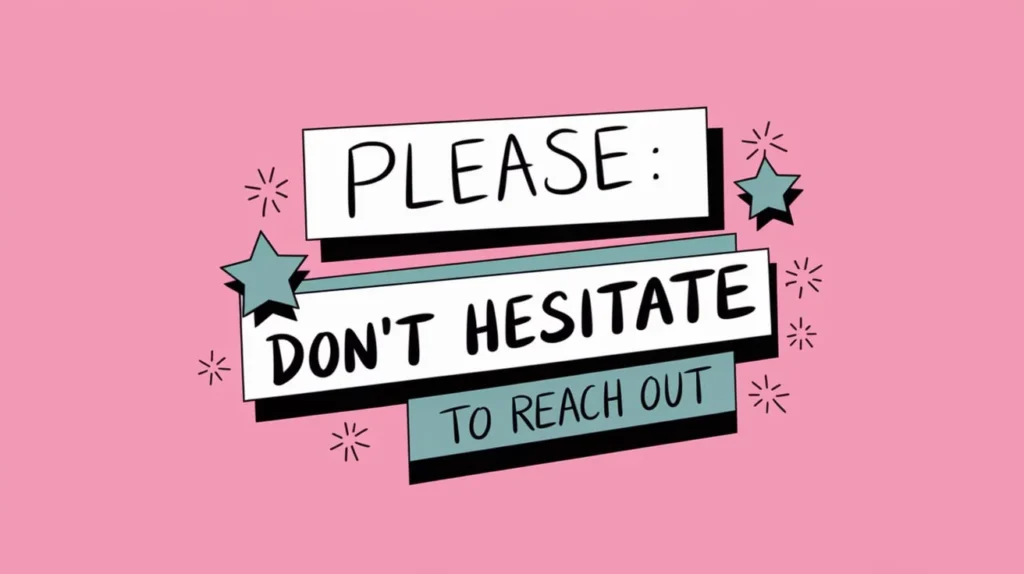We’ve all been there—sending an email and wanting to express warmth and openness to further communication. “Please don’t hesitate to reach out” is a commonly used phrase, but there are so many other ways to say it that can feel more personal, warm, or even a bit more casual.
Whether you’re writing a formal business email, a friendly note to a colleague, or reaching out to someone new, having different options at your disposal can help you sound thoughtful, approachable, and clear. This article will explore 20 other ways to say “Please don’t hesitate to reach out,” complete with examples and a breakdown of when to use each one.
What Does “Please Don’t Hesitate to Reach Out” Mean?
Before we dive into the alternatives, let’s take a moment to understand what “please don’t hesitate to reach out” means. This phrase is a polite way of saying, “Feel free to contact me anytime if you need help or have questions.” It’s often used at the end of emails or messages to reassure the recipient that you’re open to further communication and eager to assist.
It’s a friendly, non-pushy way to show you’re available and approachable. But, if you feel like mixing things up a bit, here are 20 alternatives to keep your tone just as warm, but with a fresh twist.
Is It Professional/Polite to Say “Please Don’t Hesitate to Reach Out”?
Yes! “Please don’t hesitate to reach out” is both professional and polite. It’s a friendly invitation that opens the door for continued communication. Whether you’re emailing a colleague, a client, or someone in your network, this phrase shows that you’re approachable and willing to help.
However, if you use it all the time, it may start to feel a little overused or impersonal. That’s where alternatives come in! If you’re looking to add variety and match the tone of your message a little more closely, switching it up can make your email feel more genuine.
Pros and Cons of “Please Don’t Hesitate to Reach Out”

Pros:
- Sounds polite and professional
- Makes you seem open and helpful
- Works in almost any situation
Cons:
- Can feel a bit overused
- Might sound too formal in casual conversations
- Doesn’t always feel super personal or warm
Synonyms for “Please Don’t Hesitate to Reach Out”
- Feel free to get in touch
- Don’t be shy about reaching out
- I’m always here if you need anything
- Please don’t hesitate to contact me anytime
- Reach out whenever you need help
- Don’t hesitate to contact me if anything comes up
- I’m just an email away
- Feel free to reach out anytime you need
- I’m happy to assist anytime
- Please reach out if you need anything
- Let me know if you have any questions
- You can always contact me
- Feel free to drop me a line
- Don’t hesitate to get in touch
- I’m available if you need anything
- Don’t hesitate to give me a shout
- I’m happy to help however I can
- Reach out if you need assistance
- You’re welcome to reach out anytime
- Please feel free to contact me with any questions
1. Feel Free to Get in Touch
Sometimes a more casual approach is exactly what’s needed. “Feel free to get in touch” is an inviting and laid-back way to encourage further communication without sounding too stiff.
Scenario Example:
Hey John,
I hope you’re doing well! If you need anything or have any questions, feel free to get in touch anytime. Looking forward to hearing from you!
Best,
Sarah
Best Use: Casual professional settings, friendly follow-ups, or informal emails.
Additional Note: This phrase is warm and inviting, yet still professional enough for most business settings. It’s perfect when you want to sound approachable but not too informal.
2. Don’t Be Shy About Reaching Out
Adding a touch of personality can make your invitation feel more genuine. “Don’t be shy about reaching out” lightens the tone while still being respectful.
Scenario Example:
Dear Emily,
I’m really excited to collaborate on this project! Don’t be shy about reaching out if you need any help along the way.
Best,
Mike
Best Use: Great for creative or informal industries where building rapport matters. It’s a little less formal and can make the conversation feel more personable.
Additional Note: If you’re trying to build a friendly connection or you’re working with someone new, this phrase makes it clear that you’re open to communication without sounding too stiff.
3. I’m Always Here If You Need Anything
If you want to emphasize your availability, this phrase offers reassurance with a slightly warmer tone.
Scenario Example:
Hi Mark,
I hope you’re doing well. I’m always here if you need anything or just want to bounce around some ideas.
Best regards,
Nina
Best Use: Ideal for colleagues, clients, or anyone who might need support but could be hesitant to ask.
Additional Note: This alternative puts more emphasis on your readiness to help, making it feel more like a personalized offer of assistance.
4. Please Don’t Hesitate to Contact Me Anytime
A slight variation on the original phrase, this one emphasizes the “anytime” aspect. It reassures the reader that there’s no urgency or time constraints.
Scenario Example:
Hi Lisa,
Just wanted to check in and see how everything is going. Please don’t hesitate to contact me anytime if you need anything from my side.
Warm regards,
Tom
Best Use: Works in formal or semi-formal professional environments, especially when working with clients or stakeholders.
Additional Note: It’s similar to the original phrase but adds a subtle hint of reassurance that you’re available whenever they need.
5. Reach Out Whenever You Need Help
This option keeps the invitation clear and to the point, emphasizing that you’re available for any kind of support.
Scenario Example:
Hi Rachel,
I hope all is well! Feel free to reach out whenever you need help with the report. I’m happy to assist.
Best,
David
Best Use: Excellent for situations where someone might need specific help or advice, like project collaborations.
Additional Note: It’s a friendly and approachable way to offer assistance without sounding too formal.
6. Don’t Hesitate to Contact Me if Anything Comes Up
This one acknowledges that things may pop up unexpectedly and reinforces your availability to help.
Scenario Example:
Hello Alex,
Just wanted to follow up. Don’t hesitate to contact me if anything comes up or if you have any further questions.
Best regards,
Jennifer
Best Use: A bit more formal and ideal for customer service settings or more serious professional matters.
Additional Note: It’s great for situations where the recipient might be hesitant to ask for help and you want to reassure them that it’s okay.
7. I’m Just an Email Away
Casual and friendly, this phrase is perfect when you want to make yourself sound available but without the heaviness of more formal language.
Scenario Example:
Hi Jamie,
I hope you’re having a great week! I’m just an email away if you need anything from me.
Take care,
Rachel
Best Use: Perfect for friendly professional settings or when you want to sound accessible without overdoing it.
Additional Note: It’s a little more relaxed, so best for colleagues or clients who you have an established rapport with.
8. Feel Free to Reach Out Anytime You Need
A little more conversational, this version keeps the message light but ensures the recipient knows you’re available for any inquiries or concerns.
Scenario Example:
Dear Sam,
I just wanted to check in and see how the meeting went. Feel free to reach out anytime you need further clarification.
Kind regards,
Tom
Best Use: Good for follow-up emails after meetings or discussions.
Additional Note: This phrase is straightforward and helpful without being overly formal.
9. I’m Happy to Assist Anytime
If you want to emphasize your eagerness to help, this option is a perfect fit. It shows that you’re more than willing to step in and offer assistance.
Scenario Example:
Hi Chris,
Just wanted to remind you that I’m happy to assist anytime you need help with the project or have questions.
Best,
Sarah
Best Use: Works well in client service, project management, or support-based roles.
Additional Note: This is especially helpful in a professional context when you want to remind the recipient of your willingness to help without sounding pushy.
10. Please Reach Out If You Need Anything
Simple and direct, this is a no-nonsense way to offer your help and let someone know you’re available.
Scenario Example:
Hey Charlie,
I hope you’re doing well! Please reach out if you need anything at all.
Best,
Lily
Best Use: This works well in both formal and informal settings, especially if you’re following up after a conversation.
Additional Note: It’s easy to understand and effective for when you want to keep things straightforward.
11. Let Me Know If You Have Any Questions
A bit more specific, this version invites the recipient to reach out if they have any uncertainties. It’s helpful when you expect questions or want to clarify things.
Scenario Example:
Hi Kate,
I just wanted to touch base on the report. Let me know if you have any questions about the data or anything else.
Best,
Aaron
Best Use: This works well after sharing information or documents that may raise questions. It’s a great way to let others know you’re open to clarifications.
Additional Note: This option feels a bit more formal and focused on addressing potential doubts. It’s ideal when you’re sending something that might require explanation.
12. You Can Always Contact Me
Direct and reassuring, this option gives the recipient a sense of availability at any time. It’s a simple way to let them know you’re easy to reach.
Scenario Example:
Dear Peter,
I hope your day is going well! Just a quick reminder that you can always contact me if you need any further details or assistance.
Best regards,
Sophia
Best Use: Good for formal emails when you want to offer support without sounding too casual. It’s perfect for clients or colleagues who might need further help.
Additional Note: This version is a bit more neutral, making it suitable for various situations, from client interactions to team collaborations.
13. Feel Free to Drop Me a Line
This one feels even more casual and friendly. “Drop me a line” is a fun, lighthearted way to encourage someone to reach out without any pressure.
Scenario Example:
Hi Mark,
I hope everything’s going smoothly with the new project. Feel free to drop me a line if you need any guidance or have questions.
Best,
Olivia
Best Use: Ideal for informal, friendly emails where you want to keep the tone light and approachable. Perfect for team members or close colleagues.
Additional Note: While it’s more casual, it’s still polite and can help foster a more relaxed conversation. Avoid using it with super formal clients or in very corporate settings.
14. Don’t Hesitate to Get in Touch
Similar to “Don’t be shy about reaching out,” this alternative keeps it friendly but is just a bit more professional. It’s a nice way to let the recipient know they can approach you whenever needed.
Scenario Example:
Hey Jamie,
I hope you’re doing well! Don’t hesitate to get in touch if you need anything clarified or have any concerns.
Take care,
Rachel
Best Use: A great balance between casual and professional. Use this for colleagues or clients in medium-formal settings.
Additional Note: It’s versatile and can be adapted to suit a variety of communication styles.
15. I’m Available If You Need Anything
This one is clear and helpful. It lets the recipient know you’re open to communication without being too pushy.
Scenario Example:
Hi Grace,
I hope the presentation is coming along well. I’m available if you need anything or have any questions.
Best,
Michael
Best Use: Perfect for situations where someone might need assistance but doesn’t want to bother you. This makes you sound approachable and supportive.
Additional Note: This version is useful when you want to be available but not overly insistent.
16. Don’t Hesitate to Give Me a Shout
This one adds a bit of personality and makes you sound even more approachable. “Give me a shout” is a casual and fun way to say the same thing.
Scenario Example:
Hey Brian,
I hope your week’s going well! Don’t hesitate to give me a shout if anything comes up or you need a hand with something.
Best,
Emma
Best Use: Casual work environments or situations where you’ve already built a friendly rapport. Use this for teams or close colleagues.
Additional Note: It’s an upbeat and cheerful phrase, but make sure it fits the tone of your workplace culture.
17. I’m Happy to Help However I Can
If you want to emphasize your willingness to assist, this phrase makes it clear that you’re ready to help in whatever way is needed.
Scenario Example:
Hi Jane,
I’m happy to help however I can with the project. Just let me know if you need anything.
Best,
John
Best Use: Great for situations where you want to be as helpful as possible. It’s a wonderful way to show that you’re open to offering various kinds of support.
Additional Note: This is a helpful, versatile phrase that can be used in many different contexts, from project work to customer service.
18. Reach Out if You Need Assistance
A bit more formal than others, this option is perfect for when you want to sound professional yet still approachable.
Scenario Example:
Dear Stephanie,
Thank you for your email. Please don’t hesitate to reach out if you need assistance with the upcoming presentation.
Best regards,
David
Best Use: Excellent for formal business settings, especially when dealing with clients or in customer service.
Additional Note: This phrase is straightforward and to the point, making it perfect for professional interactions.
19. You’re Welcome to Reach Out Anytime
This option emphasizes the idea that the person is always welcome to contact you, which makes it feel a bit more inclusive and inviting.
Scenario Example:
Hi Michael,
I hope everything’s going well! You’re welcome to reach out anytime if you need help or have any questions.
Best,
Laura
Best Use: Suitable for both professional and casual settings. It’s ideal for situations where you want to convey availability without being too formal.
Additional Note: It’s polite yet welcoming, perfect for encouraging others to reach out without any hesitation.
20. Please Feel Free to Contact Me with Any Questions
A slight variation on the original phrase, this one is particularly good for more formal contexts. It keeps the door open for communication and clarifies that you’re happy to assist with any questions.
Scenario Example:
Dear Tom,
Thank you for your time earlier. Please feel free to contact me with any questions you might have moving forward.
Best regards,
Maria
Best Use: Ideal for client communications or situations where you want to convey professionalism while also being accessible.
Additional Note: This is formal enough for client emails but still friendly and open.
Conclusion
Now you’ve got 20 different ways to say “Please don’t hesitate to reach out,” each offering a little variation depending on your tone, relationship with the recipient, and the situation at hand.
Whether you want to keep things formal or add a little personality to your emails, these alternatives will help you communicate more thoughtfully and meaningfully. Choose the one that fits the vibe of your message, and feel free to make it your own!















